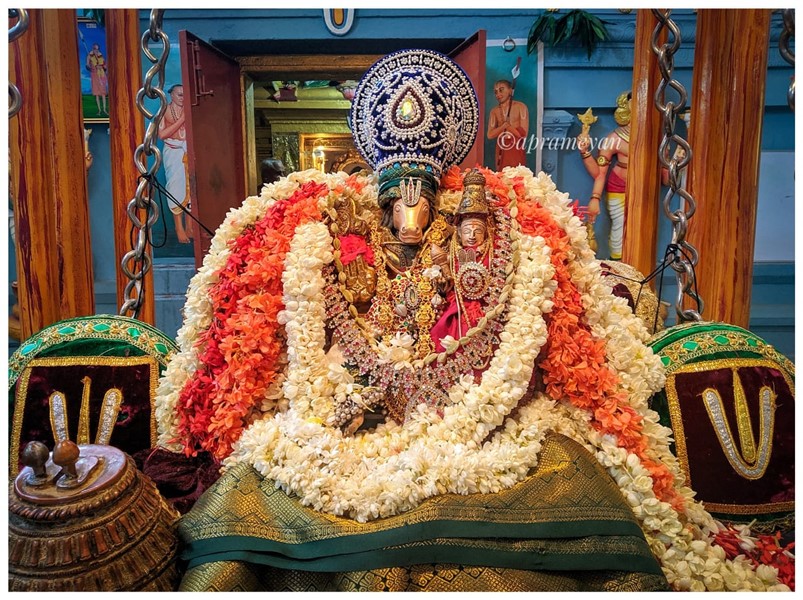jnAnAnanda-mayam devam nirmalas sphaTikAkRtim |
AdhAram sarvavidyAnAm hayagrIvam upAsmahe ||

It is well known that the Supreme Lord has incarnated Himself on several occasions for the cause of righteousness and Dharma. The most popular of these are the Dashavatarams. Besides these, there have been several more as well. One such is the avataram of Sri Hayagriva, the presiding deity of knowledge. All forms of learning and knowledge have their origin in Him and emanate from Him. The avataram of Sri Hayagriva is the foremost of all the other avatarams of Lord Sriman Narayana. It is an avataram with great significance. Brahma, Rudra, Devas, Rishis and the like have meditated upon this Lord for gaining knowledge. Bhagavan Vyasa has extolled Him as “vidya-sahaayavaan” (one who guides all forms of study). Lord Sriman Narayana after having woken up from his yoga nidra created Chaturmukha Brahma, the representation of satva gunam and ordained him with the duties of creation after having initiated him into the Vedas. Two demons Madhu, the representation of tamoguna and Kaitabha, the representation of rajoguna saw Chaturmukha Brahma singing the four vedas in a nectarous tune with his four faces. With evil designs, they plundered with the four vedas and went into the dark depths of patala lokam. A helpless Brahma having lost the splendor of his knowledge, prayed to Lord Sriman Narayana with all devotion. Pleased with his devotion, the Lord with the power of His Yoga, incarnated with a wonderful horse face. This was not a ‘man-horse’ incarnation, but instead, the manifestation of the Supreme form of vyuha Aniruddha into that of Sri Hayavadana. The Hayashiropakhyana of Mahabharata attests to this fact by saying – “अनिरुद्धतनौस्थितम्!”. It is declared in the Vedas that in order to subdue the despicable rajoguna and tamoguna, the best form of build is that of Hayashira or Hayagriva. The Lord incarnated in a resplendent spotless white form of Hayagriva with four hands (chaturbhujam). His horse head depicted the dwelling of the four Vedas showing the forms of the stellar world, His mane shone like the rays of Sun, His two ears beamed like Akasha and Patala and His forehead like the Earth, His eyebrows were vibrant like the rivers Ganga and Sarasvathi, His two eyes looked like the Sun and the Moon with oceans inside, His nose looked like dusk (sandhya) and His utterance or neigh was the supreme pranava (udgita), His tongue looked like a lightening streak, His lips looked like bhulokam and pitrulokam and His neck looked like the deep dark night. The Lord after having attained this divine and magnificent form that was the substructure for all other forms of His went after the two demons into the Patala lokam. Having terminated the demons effortlessly and redeemed the Vedas back to their pristine glory, He then taught the same to Chaturmukha-Brahma, along with the Pancharatra and other shastras. It is for this reason that Lord Hayagriva is considered the first acharya in the lineage of preceptors and also the treasure house of the Vedas and the essence of all knowledge and vidya. This G-11
avataram is full of finest truths and realizations of Vedanta. Sri Hayavadana is also celebrated as Madhusudana and Kaitabhari. From a philosophical point of view, the story of Hayagriva avataram is actually a representation of the victory of satvaguna over rajas and tamas due to the infinite mercy of Sri Lakshmi Hayavadana. The pramanam for this come from Vedavyasa who says “ सत्वामसोमधुर्जातः तदा नारायणाज्ञ्या। कठिणस्त्वपरोबिन्दुः कैटभोराजसः स्मृतः॥“
The Lord in Ramavataram preached the truths of Sharanagati and Varnashramadharma. In Krishnavataram, He preached the Bhagavath Geetha, along with vishwaroopa darshana and the destruction of the evil. In all the other avatarams of the Lord it can be seen that the Lord preaches some important truth, but it is only in Hayagriva avataram that one can have a complete realization of all the truths of Vedanta. It is said that the avatara of Hayavadana is from the krutayuga. Down the ages, many sages have meditated upon this form of the Lord to attain knowledge and spiritual perfection. Sage Vedavyasa was also a great Hayagriva upasaka. He has described the greatness of this avataram in Mahabharata shantiparva moksha dharma narayaniyam, 375 sargam, which is popularly known as Hayashiropakhyana. Shiva in the form of Dakshinamurthy and Devi Sarasvathi are also said to have adored and worshipped this Hayagriva form of Sriman Narayana. We also learn from the purvacharya parampara that Bhagavad Ramanuja made the samarpanam of his Sribhashya to Sri Lakshmi Hayagriva that was being worshipped at Sarasvathi peetam in Kashmir. Swamy Vedanta Deshika was also a great Hayagriva upasaka who received initiation into the Hayagriva mantram from none other than Garudazhwar himself. The Azhwars are also not far behind. The divyaprabandhams carry ample accounts where Sri Lakshmi Hayagriva has been celebrated and glorified by all the Azhwars. Sri Hayagriva is considered as the principal deity of all knowledge and enlightenment. One becomes wise and erudite, worshipping and contemplating on Sri Lakshmi Hayagriva. He is the “Yajnapurusha” who bestows moksha. Swamy Deshika says – नमस्त्रेधाविभक्तानां आत्मानां अन्तरात्मने। ब्रह्मणे हयवक्त्राय बन्धमोक्षैकहेतवे॥
We pray unto the twin lotus feet of this Lakshmi Hayagriva to grant mankind, the bliss of spiritual knowledge and all-round auspiciousness.
य एको दुर्लघ्यत्रिगुणनिजमायानिगलितैर्विचित्रैः क्षेत्रज्ञैः विरजति सरोजासहचरः।
जगत्सर्गक्षेमक्षपणपरिकर्मिणमहिमा दयालुर्देवोऽसौ तुरगवदनस्तारयतु नः॥
अनन्यानां पुंसां अनवधिकभक्तिस्तिथिजुषां अविद्याध्वंसो यच्चरण वरिणस्यापरिणतेः।
तदेकं सत्संवित् सुखमवधि दूरीकृतगुणं हताशेषावद्यं हयवदनमीडीमहि महः॥
